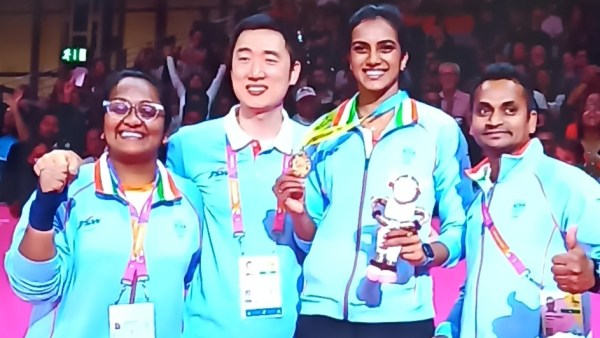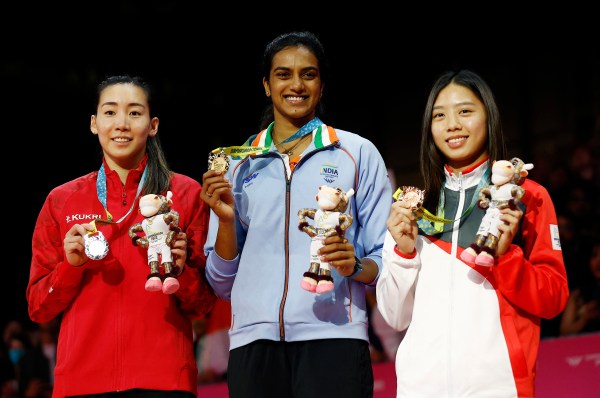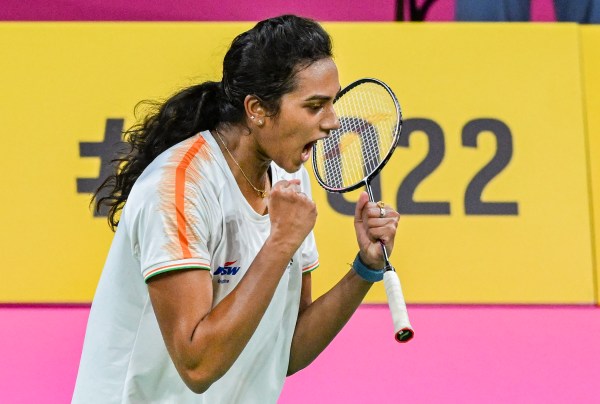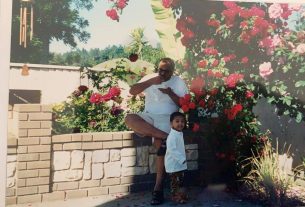Star shuttler has God-gifted talent but it’s strength & conditioning trainer Srikanth Verma who ensures she outlasts her opponents, like Michelle Li of Canada in the final
Thank you for reading this post, don't forget to subscribe!Shared News: August 8, 2022 3:29:44 pm
PV Sindhu celebrates on the podium during the medal ceremony on Monday. (REUTERS/Jason Cairnduff)
What’s happiness got to do with it? It was the question PV Sindhu and her strength and conditioning trainer Srikanth Verma pondered when they committed to turning the badminton star into a performance juggernaut.
“I never enjoy anything in life. I don’t think I will till France Olympics,” Verma had said stoically on eve of the Commonwealth Games here, explaining how even his dreams revolve around how to keep the 27-year-old fit and fighting till Paris, her third Games.
“Sometimes after she wins a title, I tell her ‘Enjoy for 2-3 days’,” he says, because happiness is on every life doctor’s prescription for success. “She’ll say, ‘No, it’s ok. I’m happy only.’ And next day, turn up for training,” he explains of someone he calls a god-gifted athlete, who still puts in an insane work rate to respect that genetic advantage.
That was evident in the gold-medal match on Monday as she showed no sign of fatigue on the final day of an event that has seen her go without a loss in both the team and individual events. Facing Michelle Li of Canada in the final, she scored a 21-15 21-13 in the final of women’s singles.
For both coach Verma and Sindhu, Birmingham was a challenge. The duo was working towards a particularly stacked month, having to peak three times – winning the Singapore Open, the Commonwealth Games next two weeks and then a short turnaround to the World Championships.

PV Sindhu with coaching staff including her trainer Srikanth. (on her left)
Sindhu’s results have been up and down since winning the 2019 World title, and the Olympic bronze, a disappointment for the world-class athlete, has clearly triggered an appetite for the Paris gold. “Age (27) is just a number. The way Sindhu is, she can play up to 40 even – if she wants.”
Verma’s job – his obsession, a research project even – has been to ensure mortal matters like injury do not interfere with Sindhu’s pursuit of greatness. All her peers – Carolina Marin, Nozomi Okuhara, Akane Yamaguchi and Chen Yufei – have spent extended periods out due to injury, but the Indian remains a persistent contender. “Even foreign experts ask me how we keep her injury-free. But it’s a secret,” he says.
Verma has regrets about his own stubbed career in sport – he ran 800 metres, and rues never receiving good advice to understand why he faded off in the final 30-40 metres, and why his injuries spelt a definitive end of his dreams. “The failure I faced left me broken. I decided I’ll become the best strength and conditioning coach in the world and moved into sport education,” he says. Verma prides himself in being able to observe an athlete for just a few minutes, and figuring out which tiniest muscle needs bolstering.
He came from a poor family, and believes he wasted eight precious years of his life meandering through mediocrity solely for lack of scientific guidance. It got him digging deep – and wide, as he spoke extensively to shot put coaches, and guided a Vizag thrower to the national podium. “Usually only North Indians won. But I kept working on ways to improve the strength of South side athletes,” he says.

Gold Medallist PV Sindhu celebrates on the podium alongside silver medallist Canada’s Michelle Li and bronze medallist Singapore’s Jia Min Yeo during the medal ceremony. (REUTERS/Jason Cairnduff)
He would travel to Spain, learn about strength techniques at tennis academies there, work with Indian boxers, tennis players and the Andhra Ranji Trophy team to compile a decade-long experience in solely improving strength and assiduously preventing injuries.
He was in Russia with Suchitra Academy’s Praveen Raju when he was invited to work with Sindhu – on a month’s audition before the 2017 World Championships. He was anxious about working with an established Olympic medallist, but supremely confident of his own techniques. “I was scared because I was only a low-level trainer. I didn’t know if she would listen to me. But she has never questioned me.”
Verma had met many parents who gave him grief because their daughters bulked up muscles, faced ridiculous questions like if their height would be stunted if the upper body went Samson. “Sindhu never asked me why her shoulders were getting bulky. In fact, I would tell her after starting any new body strength training that she’ll suffer for two days but it’ll be worth it.”
Three weeks before the All England, he put Sindhu into an off-season regimen of intense loading to last her the long season with big events coming up. Right until this Friday before flying out on Sunday for the Commonwealth Games, Verma had worked Sindhu to numbing exhaustion. “I asked her if she wanted a break after the Singapore Open. She said no.”

PV Sindhu reacts after winning the Women’s Singles Final Badminton match against Canada’s Michelle Li at the Commonwealth Games 2022 (CWG), in Birmingham, UK, Monday, Aug. 8, 2022. (PTI Photo/Swapan Mahapatra)
Verma’s earliest tweak on Sindhu had been her footwork and striding. “We identified a mechanism to reach every corner of the court. Worked different muscles to dominate from everywhere.” He would watch every match from 2017-19 to hyper-focus on the smallest muscle groups. Teaching the tall woman with long legs to unlearn and relearn the low lunge and then the high toss needed lots of resistance band variations. Her hips, glutes and ankle were trained in mobility to move at a snap second’s notice in any direction.
It’s daily questionnaires on Delayed Onset Muscle Soreness (Doms) – how sore one feels from a session – the same question every day that have helped Verma understand Sindhu’s training thresholds. “I wish I had answers to why my muscles were sore when I was failing as an athlete,” he says, glad to be the one watching an elite athlete shine along the edge of the sun.
“She was always the toughest, strongest athlete I know. I just added explosive strength and my recovery protocols have ensured she’s never injured from overloading,” he says, stressing that it’s not YouTube or Google copy-pastes of workouts but a bespoke blasting of her specific muscles in training to aid them in exploding in competition. On top days, she runs 12k. “I tell her ‘if you bear with it, and put in the work, you’ll last the tournament’.” Verma’s recovery protocols include water immersion, band stretches, hot water, jacuzzi, air compression therapies, trigger points, underwater walking, ice baths and sleep. “But it’s her natural hormones. She’s built to be a great athlete,” he says. It’s his job to maintain the momentum. Tirelessly.
It’s no wonder then he looks up to Rafael Nadal and Novak Djokovic for their relentlessness. “First 2-3 years, Sindhu was confused as to ‘why he’s making me work so hard.’ But I had her father’s permission to push hard. She never complained though. And now I ask her to work for two hours, she’ll do four hours.” Her mental maturity has improved, and she can even monitor her own recovery when he hands her a point-by-point schedule.
Curiously, it’s not the long matches that are challenging for Sindhu, whose recovery game is top-grade. “Keeping energy is no problem for her body even in long tournaments like the CWG. We are working on closing out of close matches and what she needs to do there. Coach Park (Tae Sang) will have a list and order that this and this isn’t working and needs to improve. It’s my job though to actually get it done,” he says. Even Juggernauts – gunning for CWG gold, then the Worlds – need their jugglers prepping for the joust.


